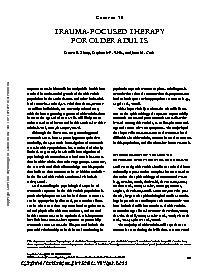Trauma-Focused Therapy for Older Adults
Improvements in biomedicine and public health have resulted in a substantial growth of the older adult population in the United States and other industrialized countries. Indeed, 12.4% of Americans, or over 40 million individuals, are currently 65 and over, with the fastest growing segment of older adults those between the ages of 85 to 94. This will likely mean an increased need for mental health services for olderadults (Karel, Gatz, & Smyer, 2012).
Although the literatures on gerontology and traumatic stress have separately grown quite dramatically, the systematic investigation of traumatic stress in older populations has remained relatively limited. In general, the scientific investigation of psychological trauma has received much less attention in older adults than other age groups.
However, the research and clinical knowledge on this population indicate that trauma can be a “hidden variable” in the lives of older adult survivors (Nichols & Czirr, 1986).
Understanding the psychological sequelae of traumatic exposure in the older adult population is particularly important so that healthcare resources can be appropriately allocated, preventative efforts can be taken to reduce any associated negative mental and physical health concomitants, and mental health treatments can be optimized.
It is important for clinicians to assess for exposure to potentially traumatic events across the lifespan and include the potential relationship to health care functioning in psychotherapeutic treatment plans.
Misdiagnosis r underdetection of trauma-related symptoms can lead to inadequate or inappropriate treatment (e.g., Hegel et al., 2005). This chapter briefly reviews the scientific literature on the epidemiology of exposure to potentially traumatic events and posttraumatic stress disorder (PTSD) among older adults, as well as phenomenology and course of PTSD symptoms.
The majority of the chapter discusses assessment of trauma-related difficulties in older adults, trauma-focused treatments in this population, and directions for future research.
Geachte bezoeker,
De informatie die u nu opvraagt, kan door psychotraumanet niet aan u worden getoond. Dit kan verschillende redenen hebben,
waarvan (bescherming van het) auteursrecht de meeste voorkomende is. Wanneer het mogelijk is om u door te verwijzen naar de bron
van deze informatie, dan ziet u hier onder een link naar die plek.
Als er geen link staat, kunt u contact opnemen met de bibliotheek,
die u verder op weg kan helpen.
Met vriendelijke groet,
Het psychotraumanet-team.
In: S. N. Gold(ed), APA Handbook of Trauma Psychology: Trauma Practice Vol. 2., [Washington, DC] : American Psychological Association | 431-448
http://www.apa.org/pubs/books/4311531.aspx
Chapter 20


